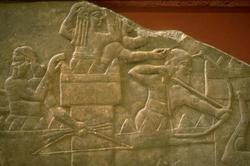How Did Writing Start?
No one can know for certain, of course, but here is a theory that has won considerable acceptance. In the Fertile Crescent land of Sumer, possibly as early as 8,000 B.C.E., small clay triangles, spheres, cones, and other tokens were molded to represent sheep, measures of grain, jars of oil, and other goods. It is theorized that these tokens served a community as a means of keeping track of goods for the purpose of pooling and redistributing the community’s resources. They were sometimes placed in burial sites, and may have also indicated gifts to the temple, tribute to a ruler, or tax payments. The shape of the token carried its meaning.
Starting around 3,700 B.C.E., the tokens were placed in hollow clay balls, a kind of envelope, for storage. It must have been frustrating that, once the tokens had been sealed inside, there was no way to determine the contents without cracking the ball open. This was solved either by fixing an identical token in the ball’s soft surface or leaving an impression by pressing the token against the wet clay before it hardened.
The next step toward writing was taken by scratching a representation of the token in the clay. Surviving specimens in museums do not match the shape of the tokens, indicating an important step toward abstract thinking.
Because the outside markings carried the meaning, there was really no need to stuff tokens inside a hollow ball. Without tokens, the ball could be flattened to the shape of a tablet.
About 3,100 B.C.E., the Sumerians invented numerals, separating the symbol for sheep from the number of sheep, so writing and mathematics may have evolved together. Diggings at Uruk show that the Sumerians advanced from simple pictographs to ideographic writing, in which a symbol represented a concept.
Now writing was developing into a tool that could communicate ideas.
For more information, go to: http://www.emayzine.com/lectures/sumeria.htm
